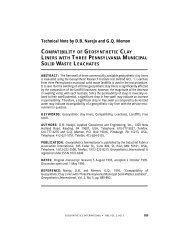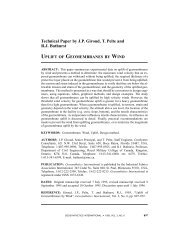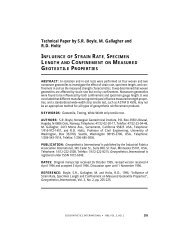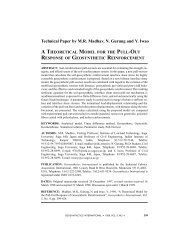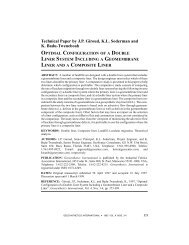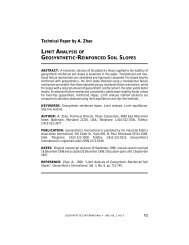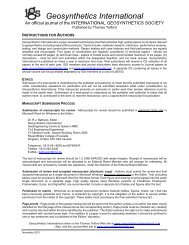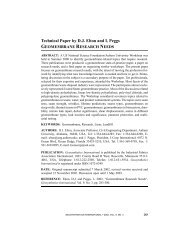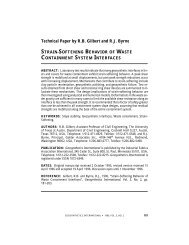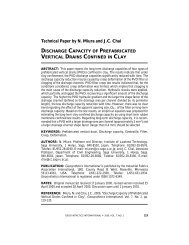leachate flow in leakage collection layers due to defects in ...
leachate flow in leakage collection layers due to defects in ...
leachate flow in leakage collection layers due to defects in ...
Create successful ePaper yourself
Turn your PDF publications into a flip-book with our unique Google optimized e-Paper software.
GIROUD et al. D Leachate Flow <strong>in</strong> Leakage Collection Layers Due <strong>to</strong> Geomembrane Defects<br />
ity, k. The lam<strong>in</strong>ar <strong>flow</strong> assumption is applicable <strong>to</strong> sand and approximately applicable<br />
<strong>to</strong> gravel and geonets. Furthermore, it is assumed that the hydraulic conductivity,<br />
k, of a given <strong>leakage</strong> <strong>collection</strong> layer material has a unique value, that is the hydraulic<br />
conductivity of the saturated material.<br />
S The <strong>leachate</strong> is assumed <strong>to</strong> have the same density and viscosity as water. This assumption<br />
should be satisfied <strong>in</strong> the case of all modern landfills <strong>due</strong> <strong>to</strong> the generally low<br />
concentration of chemicals <strong>in</strong> <strong>leachate</strong>. As a result, the values of the hydraulic conductivity,<br />
k, of the <strong>leakage</strong> <strong>collection</strong> layer material measured us<strong>in</strong>g water are applicable<br />
<strong>to</strong> <strong>leachate</strong> <strong>flow</strong>.<br />
S The <strong>defects</strong> <strong>in</strong> the primary l<strong>in</strong>er are assumed <strong>to</strong> have a small dimension <strong>in</strong> all directions<br />
of the plane of the geomembrane so that the result<strong>in</strong>g leaks can be treated as<br />
po<strong>in</strong>t source leaks. Examples of such <strong>defects</strong> are circular or quasi-circular holes <strong>in</strong><br />
geomembranes with a diameter (or an equivalent diameter) of less than approximately<br />
10 <strong>to</strong> 20 mm (i.e. a surface area less than approximately 1 <strong>to</strong> 3 cm 2 ). Examples of<br />
<strong>defects</strong> that are not consistent with the above assumption are <strong>defects</strong> with a surface<br />
area larger than approximately 3 cm 2 and <strong>defects</strong> with a great length such as cracks<br />
or a relatively long length of open seam <strong>in</strong> a geomembrane.<br />
S The rate of <strong>leachate</strong> migration through a given defect is Q under steady-state <strong>flow</strong><br />
conditions, which are assumed <strong>to</strong> exist <strong>in</strong> all cases.<br />
S It is assumed that <strong>flow</strong>s through various <strong>defects</strong> do not <strong>in</strong>terfere. In other words, the<br />
wetted zones related <strong>to</strong> different <strong>defects</strong> do not overlap. (Cases where wetted zones<br />
may overlap are discussed <strong>in</strong> Section 4.4.5.)<br />
S Capillarity <strong>in</strong> the <strong>leakage</strong> <strong>collection</strong> layer is not considered (which limits the validity<br />
of the study by exclud<strong>in</strong>g <strong>leakage</strong> <strong>collection</strong> <strong>layers</strong> constructed with f<strong>in</strong>e sands) and<br />
the secondary l<strong>in</strong>er is assumed <strong>to</strong> be impermeable (i.e. it is a geomembrane with no<br />
<strong>defects</strong>, possibly on a clay layer, but not a clay layer alone). Therefore, all of the <strong>leachate</strong><br />
that passes through <strong>defects</strong> <strong>in</strong> the primary l<strong>in</strong>er <strong>flow</strong>s <strong>in</strong> the <strong>leakage</strong> <strong>collection</strong><br />
layer.<br />
Other assumptions will be made as required at various steps <strong>in</strong> the analysis.<br />
2.2 AssumptionsSpecific <strong>to</strong> the Case Where the Leakage Collection Layer is not<br />
Full<br />
As mentioned <strong>in</strong> Section 1.2.2, two cases are discussed <strong>in</strong> this paper: the case where<br />
the <strong>leakage</strong> <strong>collection</strong> layer is not full and the case where the <strong>leakage</strong> <strong>collection</strong> layer<br />
is full. The former will be the lead case, and results for the case where the <strong>leakage</strong><br />
<strong>collection</strong> layer is full will then be derived from results for the case where the <strong>leakage</strong><br />
<strong>collection</strong> layer is not full.<br />
In the case where the <strong>leakage</strong> <strong>collection</strong> layer is not full, the <strong>flow</strong> rate through the<br />
considered <strong>defects</strong> <strong>in</strong> the primary l<strong>in</strong>er is assumed <strong>to</strong> be small enough that the maximum<br />
thickness of <strong>leachate</strong> <strong>in</strong> the <strong>leakage</strong> <strong>collection</strong> layer is less than the thickness of the <strong>leakage</strong><br />
<strong>collection</strong> layer. In this case, assumptions regard<strong>in</strong>g the hydraulic gradient and the<br />
shape of the phreatic surface can be made, as described below.<br />
As <strong>in</strong>dicated <strong>in</strong> Section 1.2.1, the <strong>leachate</strong> that, has passed through a defect <strong>in</strong> the primary<br />
l<strong>in</strong>er, first <strong>flow</strong>s more or less vertically through the <strong>leakage</strong> <strong>collection</strong> layer upper<br />
220 GEOSYNTHETICS INTERNATIONAL S 1997, VOL. 4, NOS. 3-4



